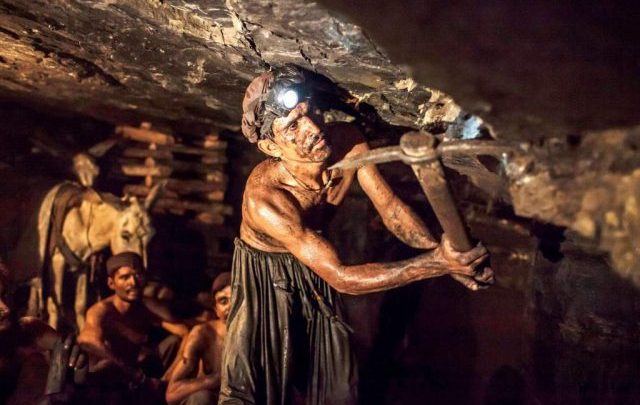After going through the Evolution chapter in the intermediate (part two) Biology Book, I wondered how Muslims are doing injustice with the theory of Evolution. The professor, who compiled this book, has raised some questions at the end of the chapter which repudiates the concept of evolution. In the light of the following quote,” nothing in biology makes sense except in the light of Evolution” by the evolutionary biologist Theodosius Dobzhansky, it’s crystal clear that denying the concept of evolution is tantamount to the rejection of Biology.
The concept of evolution has always been treated as a fallacious anecdote, and against the natural process among the Muslims. Every other Muslim would pass loathsome comments regarding evolution and curse Charles Darwin, the pioneer of evolution. The gravity of the matter can be gauged from the fact that even many educated Muslims behave this theory the same way. Worst still, the teachers and students of Biology also deal with evolution as part of the syllabus, and nothing else.
They see this concept as a conspiracy against Islam and believe that it would shake the fundamental of our Deen. This approach in general and in particular in academia is disastrous. Religion and science, in the first place, have no comparison because both see the world through different lenses. The former views the world how it ought to be? and the later see it as how the world is? However, some Muslim Mujtahids try to reconcile Islam with science. In fact, in the view of some religious scholars, evolution is true except for the creation of humans. They believe in the whole story of other animals but when it comes to the creation of humans they acknowledge the theory of special creation. To me, this is a moderate approach.
Now come to how Biology is treated as a subject with special reference to evolution in Pakistan. As I mentioned earlier about the FSC Biology book, was the author trying to present the Muslim version of evolution? Or she/he didn’t know about evolution?
The questions raised in the book have valid and reasonable answers. From now onward I will try to answer the questions raised in the book against evolution. I will focus on the most important biological questions that students must know. Moreover, all questions are listed together and their answers are given in the form of paragraphs because some questions have the same answers and most of the events are in order.
Questions:
1. The first and foremost question is how prokaryote cells came into being?
2. How does it starts division?
3. How proteins, the most complicated organic compounds formed of units called amino
acids were for formed.
4. How nucleic acids, which are also complicated organic compounds formed of units called nucleotides, were formed?
5. What is the probability of foundation of these two essential organic compounds
together? As for the synthesis of one, the other is required. If for example both of the above
organic compounds were formed by a chance factor, which is practically impossible, at different places then the evolution of a cell and its further division would not have been
possible.
6. How do autotrophic cyanobacteria develop chlorophyll?
7. The chromosome of prokaryotes is circular while the chromosomes of eukaryotes are of different shapes and sizes. How do these differences develop?
8. How other membranous structures such as Golgi bodies, endoplasmic reticulum,
lysosomes, peroxisomes, etc were evolved?
9. If billions of prokaryotes are cultured together for a hundred years what will be the
probability of evolution of a eukaryotic cell like the one claimed at the beginning’!
10. What is the probability of developing a living cell from the material ( components) of the cell
putting together?
11. The most important question is what is life? How is it originated?
12. If evolution is a blind process for example why is it stopped on human beings? If not what
type of organisms will evolve from humans and when will it start?
I have answered the questions in paragraphs form for better understanding and to avoid repetition. Starting from the first question,
It’s a very basic question and no one can expect such a question from veteran professors and writers. This question has not only been explained at full length but also demonstrated experimentally. One needs to study chemical evolution. Haldane and Oparin proposed that earth’s primitive atmosphere consisted of simple compounds such as water, molecular hydrogen, methane, and ammonia, but lacked oxygen gas in its molecular form. In simple words, primitive earth’s atmosphere was reducing one. During this time, the earth was bombarded by large comets and meteorites, generating heat that repeatedly vaporized its oceans. This reducing atmosphere was conducive to the prebiotic synthesis that led to life’s beginnings, although unsuited for the organism that is alive today.
Haldane and Oparin proposed that ultraviolet radiation of such a gas mixture caused many organic substances, such as sugars and amino acids, to form. Haldane proposed that the early organic molecules accumulated in the primitive oceans to form a ” hot dilute soup,”. In this primordial broth, carbohydrates, fats, proteins, and nucleic acids could have assembled to form the earliest structures capable of guiding their replication.
Now the question arises if the simple gaseous compounds present in the early atmosphere are mixed with the methane and ammonia in a closed glass system and kept at room temperature, they never react chemically with each other. Haldane proposed that to produce a chemical reaction, a continuous source of free energy sufficient to overcome reaction_ activation barriers must be supplied. Sources for free energy are ultraviolet rays from the sun, in the absence of the ozone layer, and electrical discharge.
Yet another hypothesis maintains that life could have been originated beneath the sea or around them and the source of energy was widespread volcanic activities.
The above-mentioned argument seems fallacious to many critics. However, this theory has been substantiated by a scientist named Miller. He produced the same conditions in the laboratory as that of primitive earth’s atmosphere i.e., reducing one. He noticed that most of the relatively few substances formed were compounds found in living organisms. This result was surely no coincidence, and it suggests that prebiotic synthesis on the primitive earth may have occurred under conditions not greatly different from those that Miller simulated.
However, the Miller experiment was criticized in the light of its currency opinion that the early atmosphere on earth was quite different from Miller’s strongly reducing simulation. Nevertheless, Miller’s work was repeated by many other scientists and reached the same conclusion: for the formation of amino acid a strongly reducing atmosphere and violent energy sources are needed.
After the formation of amino acids and nucleic acid, the next stage of chemical evolution was the formation of polymers such as proteins and nucleic acids. Such synthesis does not occur easily in dilute solutions, because excess water drives the reaction towards decomposition. Therefore, the primitive ocean might have been a primordial soup.
Again a question has been asked in the textbook how does protein formation take place? For the formation of protein, enzymes are needed and they are proteins. The answer to the question is thermal condensation. For the most Biological polymerization, condescension, dehydration, is necessary. This process of dehydration doesn’t proceed in the absence of enzymes. However, dehydration reactions could have occurred without enzymes in primitive earth conditions by thermal condensation. The simplest dehydration is accomplished by driving water from solids by direct heating. For example, heating a mixture of all 20 amino acids to 180 degrees Celsius produces a good yield of polypeptides.
It’s a well-settled fact that life is the combination of polymers: biological molecules. After the arrangement of polymers, the first living organisms protocells came into being having autonomous membrane-bounded units with a complex functional organization that permitted the essential activity of self-reproduction. Now the principal problem in understanding the origin of life is explaining how the primitive chemical system could have become organized into the living, autonomous, self-reproducing cells.
As we have already seen a lengthy process of chemical evolution, in later stages of evolution DNA and RNA, genetic materials, began to behave like a simple genetic system that directed the synthesis of proteins, especially enzymes. However, this conclusion leads to a troublesome chicken egg paradox: (1) how could nucleic acids have appeared without the enzymes that catalyze their synthesis? (2) How could enzymes have evolved without nucleic acids to encode their amino acid sequence? These questions come from a long-accepted notion that only proteins could act as enzymes. Starting evidence presented in the 1989s indicates that RNA in some instances has catalytic activity.
Catalytic RNA ( ribozymes) can mediate the processing of messengers RNA ( removal of introns) and can catalyze the formation of peptide bonds. Strong evidence suggests that the translation of mRNA by ribosomes is catalyzed by their RNA, not protein, content.
Therefore, the earliest enzymes could have been RNA and the earliest self-replicating molecules could have been RNA. Investigators are now calling this stage the ” RNA world”. Nonetheless, proteins have several important advantages over RNA as catalysts and DNA is a more stable carrier of genetic information than RNA. So, natural selection could have acted on protocells.
Later on, metabolism originated and autotrophs were given preference over heterotrophs, the earliest microorganisms were primary heterotrophs because they relied on environmental sources for their food. Autotrophs would have had a tremendous selective advantage over the primary heterotrophs in areas where organic nutrients became depleted. The evolution of autographs organism most likely required the acquisition of enzymatic activities to catalyze the conversion of inorganic molecules to more complex ones, such as carbohydrates. Meanwhile, autotrophy evolved in the form of photosynthesis. As a result, oxygen produced by photosynthesis accumulated in the atmosphere. Owing to the atmospheric oxygen accumulation, ozone began to form and absorbed ultraviolet rays. More importantly, the aggregation of oxygen gave rise to a new and highly efficient kind of metabolism: oxidative ( aerobic) metabolism.
From prokaryotes, fossils evidence suggests, single cells eukaryotes arose at least 1.5 billion years ago. However, the American biologist Lynn Margulis and others have proposed that eukaryotes didn’t arise from any single prokaryotes but were derived from a symbiosis of two or more types of bacteria. This hypothesis can be substantiated by the fact that DNAs present in plastids and mitochondria of eukaryotic cells are closer in their evolutionary history to bacteria than to the eukaryotic nuclear DNA. Hence, in this way a single eukaryotic cell appeared. In the due course of time, multicellular eukaryotes arose, natural selection acted upon them and life diversified.
Nevertheless, yet another question is often asked by the opponent of evolution: why evolution stop on human beings? Humans have not stopped evolving. Evolution is a change in the frequency of heritable traits within a population across generations. It only stops when there are no more generations, i.e. when a species abruptly goes extinct. But the pace of evolution is slow in humans as compared to bacteria due to their slow rate of reproduction. A promising example of evolution in bacteria is its resistance to antibiotics. Bacteria adapt themselves to different generations of antibiotics via changes in their genes, and this is evolution. We can study it owing to its high rate of reproduction.
Moreover, when someone talks about evolution, the next question is asked are humans evolved from monkeys? But it is not so. All the great apes are distant cousins of each other and are even more distant cousins of various species of other monkeys. All are descended from a distant, though common ancestor which is long ago deceased and extinct. Neither humans evolved from monkeys nor monkeys evolved from humans. Both are the sister group having the same ancestor.
After the whole debate, I request textbook board KP to revise the evolution chapter in the second-year biology book in the better interest of the students. The writer should study higher-level biology books like Integrated principles of Zoology, Evolution by Douglas Futuyma; Biology by Campbell, and Verma and Agarwal. It will not only help students but also make society more scientific.








